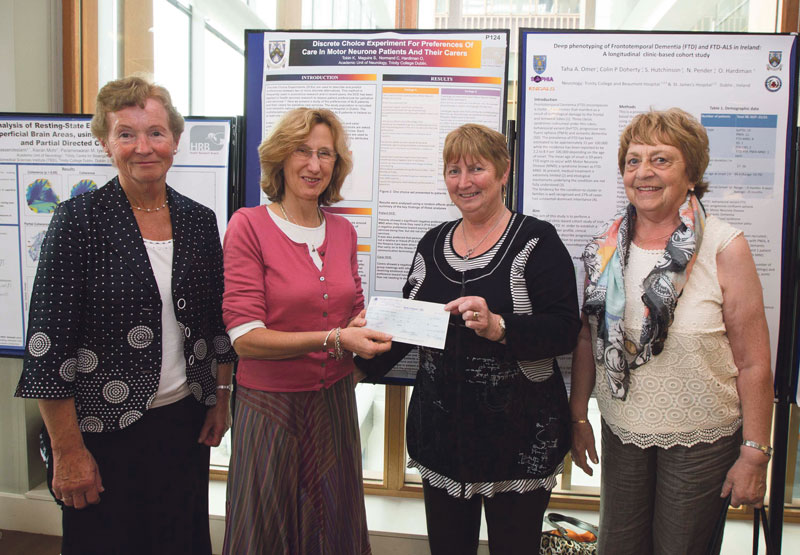Made somewhat famous in 2014 by the ice bucket challenge phenomenon, motor neurone disease (MND) is a chronic neurodegenerative disease with symptoms that are ultimately fatal. Although rare (between two and three in every 100,000 people in Ireland live with the disease) the impact of motor neurone disease is devastating. It is known as the 1,000-day disease, because sufferers generally live for only two to three years after being diagnosed, and for most, if not all, there is no beneficial way for staving off the decline of their health. Unfortunately, MND is almost always a terminal disorder.
However, despite these bleak figures, thousands of scientists, nurses, doctors and psychologists work relentlessly every day to advance the treatments of MND and to improve the quality of life of those who suffer from it. Prof Orla Hardiman, the head of neurology in both Trinity and Beaumont Hospital, is one of these, having dedicated a substantial amount of her career to the advancement of the treatment and understanding of the disease.
Speaking to The University Times, Hardiman explains that motor neurone disease was originally misunderstood: “It was initially thought to be a muscle and nerve disease, but now we know it has more in common with other neurodegenerative disorders like Parkinson’s disease and Alzheimer’s.”
The causes of MND are not completely defined, but according to Hardiman, 10 per cent of cases in Ireland are due to mutations in gene known as “C9orf72”. The other 90 per cent of cases are due to a combination of genetics and environmental factors, but, as Hardiman confesses, “we don’t really know what they are”.
MND is not an incurable disease. It’s an underfunded disease
“What we do know”, she says, “is that if you were to plot this mathematically, there are five or six steps required to get MND. We don’t know what those steps are, but you can calculate mathematically that a certain number of events need to happen for a person to get the disease. We know if you have the C9orf72 gene, the number of steps you need to get MND is two or three. So clearly it’s a gene–environment interaction, but understanding what these environmental factors are is very difficult to look at because it’s a rare disease and it’s quite difficult to look at environmental factors in rare diseases”.
Hardiman explains that the symptoms for MND depend on where the disease begins: “It’s a mostly motor-system degeneration disease, although up to 30 to 50 per cent of people will develop some thinking trouble, problems in cognition and problems in behaviour, so it depends really on where it starts and it can start in a number of different places. The peak age of onset is in the 60s, but it can start at any age.”
Similar to the majority of neurodegenerative diseases, treatment options for MND are scarce. Hardiman immediately acknowledges when asked about treatment options that “there’s no cure”, nor “any good treatment that’ll slow the disease down”. However, it has been observed that among mixed populations, where people have genes from different races, there is a reduced risk of developing MND. “They showed in Cuba that the risk of dying of MND in people who are mixed race, between Spanish and African, have lower mortality rates in MND compared to people who are of primarily Spanish extraction. So, it looks like mixing your genes with other ancestral groups is actually protective.” This echoes a plethora of research that suggests mixing between populations reduces the risk of developing a myriad of genetic disorders.
Hardiman explains how the lack of research regarding treatment of MND was what inspired her to begin a career in this field. “I was working in a neuromuscular clinic in Beaumont and I was beginning to see people with MND. I was kind of running two different research projects at that stage, one on Duchenne muscular dystrophy, and also seeing people with other neuromuscular disorders. I saw a lot of MND and a lot of people with post-polio syndrome, and it became obvious to me that there was a massive unmet need in all of these diseases, but particularly in MND. MND is an adult-onset disease and I’m trained as an adult neurologist, and these people, they get the disease and there was very little for them.”
There was very little understanding of the disease in the world, and also very poor services for people with the disease
“They got the disease, the disease progressed, and they died”, she says. “There was very little understanding of the disease in the world, and also very poor services for people with the disease. My research went on a twin track for quite a long time, both in MND and muscular dystrophy, but in terms of making a difference, putting in services and trying to understand the disease, I felt there was more I could offer in the MND domain.”
However, research into rare diseases such as MND poses particular challenges for scientists. “It’s hard to get companies interested to develop a new drug”, Hardiman explains. “Even recognising and providing services and providing integrated care, rare diseases are disenfranchised for many reasons.” Despite this, Hardiman carries out a wide range of research, ranging from epidemiology to genetic research. With a lab that staffs approximately 30 scientists, from research assistants and PhD students to fully fledged principal investigators, Hardiman’s lab is most certainly at the forefront of MND research.
I ask Hardiman if there is any one thing that she wishes the world knew about MND. She ponders for a moment. “MND is not an incurable disease”, she finally responds, “it’s an underfunded disease. If you focus enough minds and you put very clever people on the job and you recognise all the bits of things you need to understand about the disease, you can make a difference”.







